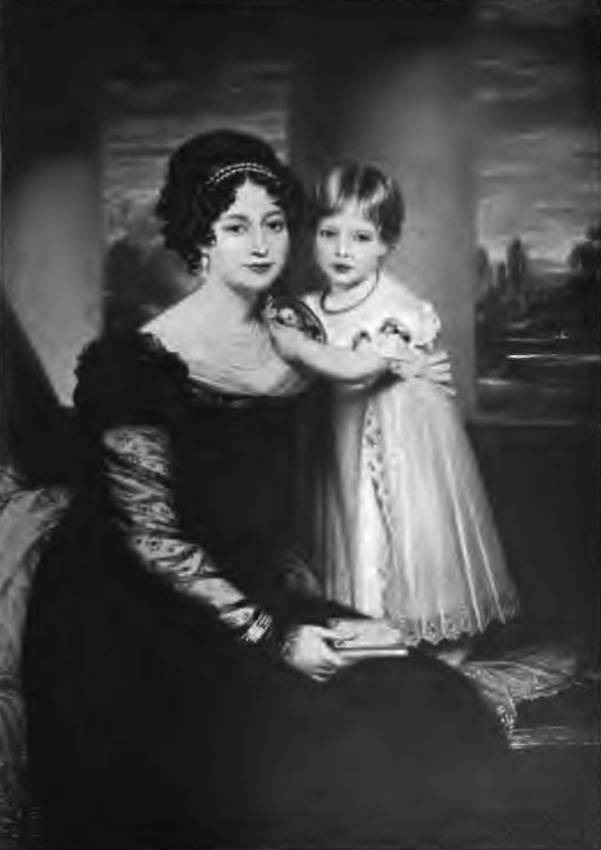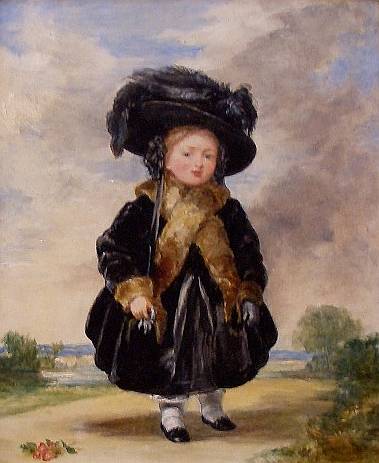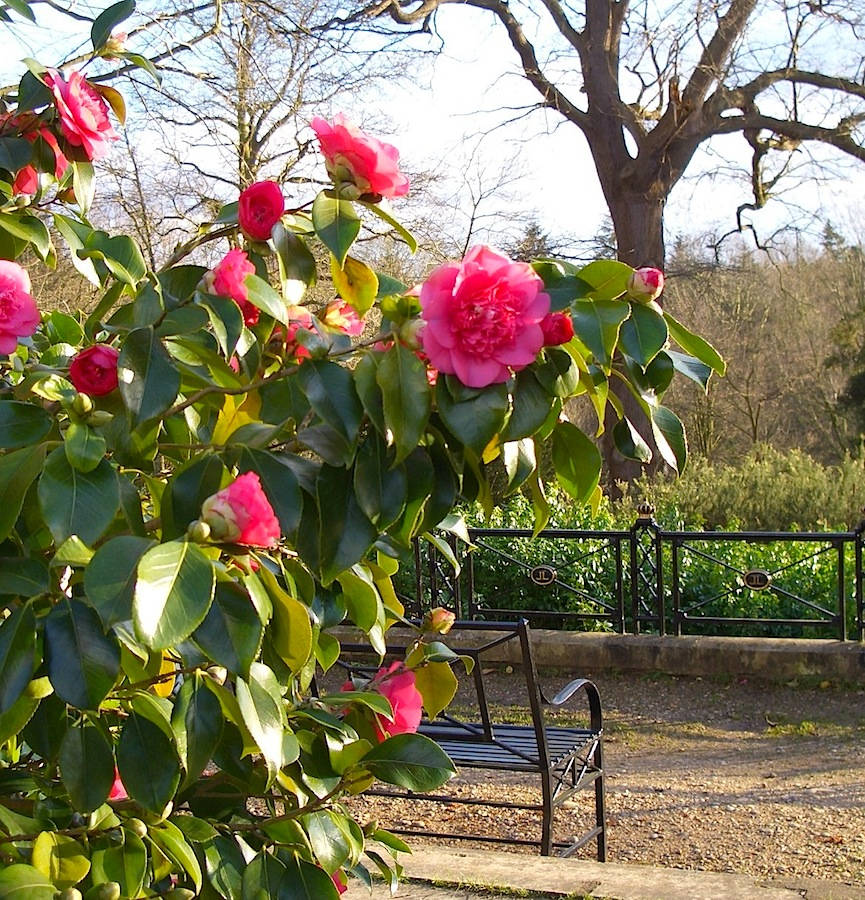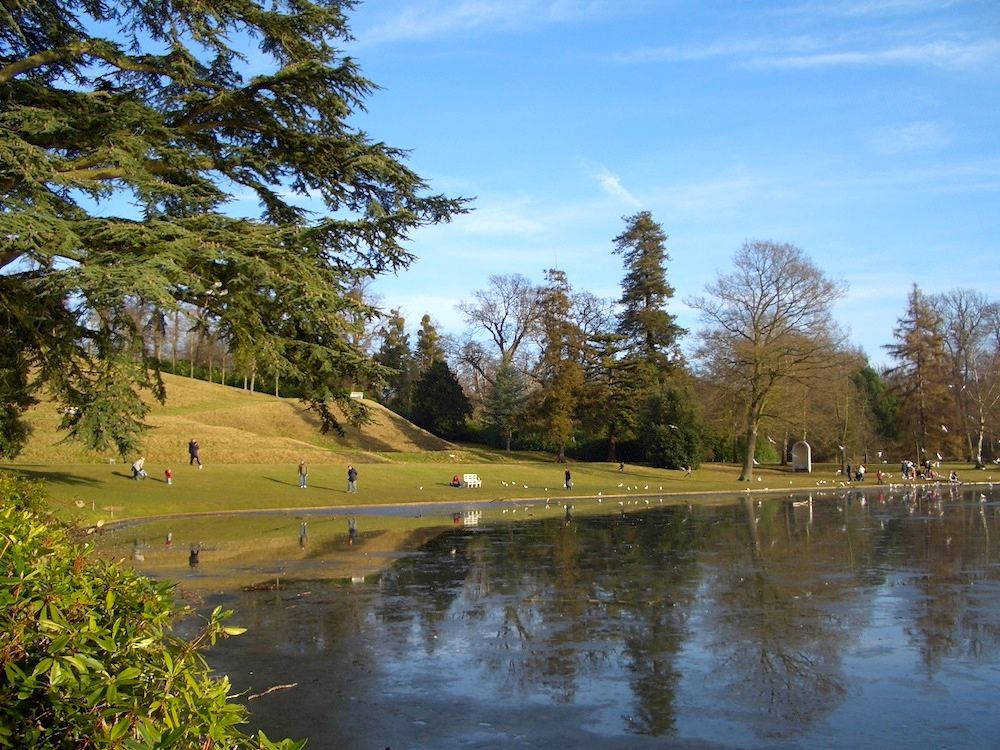This is a later version of an article first published in This England (Autumn 2012: 54-57), with all photographs and image retrieval by the author. Denning's painting of the young Queen Victoria is reproduced here by courtesy of the Dulwich Picture Gallery, but you can use the other images without prior permission for any scholarly or educational purpose as long as you (1) credit the photographer/source, and (2) link your document to this URL in a web document or cite the Victorian Web in a print one. Click on the images for larger pictures.

The house at Claremont, by Lancelot "Capability" Brown, his partner Henry Holland and Holland's pupil, John Soane. 1771-1779. A dignified neoclassical building of honey-coloured brick with stone dressings, it stands close to the main London-Portsmouth Road on the southern border of Esher, Surrey.
Claremont and its grounds are both Grade I listed, and a number of structures in the grounds are also listed. About fifteen miles from the capital and only a little further from Windsor Castle, the estate is ideally placed for a country retreat, and has had a long association with the royal family — particularly Queen Victoria.
Early History: The Eighteenth Century



Claremont's grounds. Left to right: (a) Sir John Vanbrugh's Belvedere from 1715. The beech hedge bordering the approach is lovely at all seasons. (b) Looking across the corner of the lake towards the grassy amphitheatre, another element of the gardens created in the days of Vanbrugh. (c) The amphitheatre, seen from the far side of the lake.
Claremont's illustrious history started in 1709, when the architect and Restoration dramatist John Vanbrugh bought the farm and woodland that occupied the area, and began to build the original small house there. In 1714 he sold the estate to his friend, the Earl of Clare and future Duke of Newcastle, who gave it the name by which it is now known, and asked Vanbrugh to extend the house for him and help to design the gardens. One result was the Belvedere of 1715, on a little hill to the west of the house: "astonishing — one of Vanbrugh’s most characteristic designs and historically of great significance as an early example of medievalism" (Nairn and Pevsner 161). Twice Prime Minister, the Duke lived extravagantly, implementing a continuous programme of improvements. In the hands of two of the most famous landscape designers of the day, Charles Bridgeman and William Kent, Vanbrough's original formal gardens gradually gave way to what the list entry calls the "[e]xtensive and complex pleasure grounds and park" that capitalise on the natural sweep of the ground, with a dramatic grassy amphitheatre overlooking a lake, complete with island and classical temple. Claremont now became one of the three or four most celebrated landscape gardens in the whole country (see Chessum 4). Fishing and punting, as well as riding, were popular pastimes for Newcastle and his guests, who would picnic in grounds now richly stocked with a variety of fine trees, sheep, cattle, and more exotic animals penned into a menagerie. In those years of deep pockets and high fashion, there was a good deal of conviviality at Claremont: dancing, gambling, billiards, cock-fighting and so on, and no doubt also political intrigue. Among those who enjoyed Newcastle’s lavish hospitality were George I, and later George II, Queen Caroline and other members of the royal family.

A more curious reminder of the Newcastle era: a stone bear, one of three statues (the others are a boar and a peacock) which once made up an ensemble relating to the Duke of Newcastle's coat of arms, in the centre of the original circular lake.
But there was tragedy at Claremont as well. Newcastle eventually had to mortgage the estate to his friend, Lord Clive, who intended to settle there after his return from India. Clive had the house rebuilt on higher ground, in a grander style. As indicated under the main picture, Capability Brown, Henry Holland and Holland's pupil John Soane all had a hand in this larger mansion. Its warm off-white neoclassical façade with its grand flight of steps, tall Corinthian columns and portico, and its long balustraded parapet, give it an impressive frontage, and lead into a strikingly contrastive entrance hall with red scagliola columns, an oval ceiling, and oval-patterned stone flooring, probably designed by the young Soane (see Nairn and Pevsner 161). But Clive never had a chance to adorn the richly appointed interior with his collection of Old Masters, Indian artefacts and other fine works, let alone test his new home’s marble plunge bath and other novel amenities. He committed suicide in 1774, the year of its completion, perhaps because of the "precipitous fall in his political fortunes" as well as his ill health (Dirks 341, n.16). It would not be the only tragedy associated with the house.
The Early Nineteenth Century: A Royal Residence

Triptych in memory of Prince Leopold and Princess Charlotte by local sculptor Francis John Williamson in St George's Church, Esher. Commissioned by Queen Victoria herself, it shows the young royal couple out walking with their dog, stopping to greet some townsfolk. An angel hovers above them as the princess bestows some bounty on the little girl. Princess Charlotte's deathbed is shown on the left, and Leopold's acceptance of the Belgian crown on the right, with Britannia looking on.
Claremont continued to have a chequered history. A period of inoccupancy was followed by several short ownerships, culminating in the longer one of Charles Rose Ellis, MP, who became Baron Seaford. Unfortunately, his wife died of consumption the year after he acquired the estate. After passing through the area in May 1813, and apparently hearing something of its history, Jane Austen described Claremont to her sister Cassandra as "a house that seems never to have prospered" (87). Nevertheless, when Seaford finally sold up in 1816, a young couple settled on it as their future home. Since one of them was Princess Charlotte, only child of the future George IV and therefore heiress presumptive to the throne, it was acquired and presented to them by the government as a wedding gift. Claremont now became one of the royal residences, and its fortunes seemed set to revive.

Princess Charlotte's Mausoleum at Claremont, its Gothic details attributed to Auguste Pugin. Source: Harris 314.
All went well at first. The princess proclaimed the place a "real paradise…. the most fit royal residence that can be found anywhere" (qtd. in Chessum et al. 46). The household doted on her, and the people of Esher took her to their hearts. The town celebrated her twenty-first birthday with much fanfare, decorating the shop-fronts and sending out the band. Everyone hoped that the succession would now be secured by the birth of a male heir. But, after two miscarriages, the previously robust princess bore a still-born son on 5 November 1917; at the crack of dawn the next day, she herself passed away. Her husband, Prince Leopold of Saxe-Coburg, younger son of a German princeling, was sent reeling, and the country’s hopes were shattered. Lord Byron, in Venice at the time, said that the "death of the Princess Charlotte has been a shock even here, and must have been an earthquake at home" (74). The princess’s obstetrician, Sir Richard Croft, unable to bear his own part in the drama (or the criticisms levelled at him for his handling of it), shot himself a few months later while attending another difficult labour. Prince Leopold had the teahouse at the top of the amphitheatre turned into a mausoleum for the Princess, and it is thought that Auguste Pugin, A. W. N. Pugin's father, had a hand in its Gothic detailing (see Wilson). It was demolished in the 1920s.
Queen Victoria's Early Visits to Claremont



Left to right: (a) HRH The Duches of Kent and the Princess Victoria, from the miniature by H. Bone, after Sir W. Beechey, at Windsor Castle. Source: Letters of Queen Victoria I: facing p. 8. (b) Queen Victoria, Aged 4, as painted by Stephen Poyntz Denning. (c) Queen Victoria receiving the news of her accession to the throne, June 20, 1837, from the picture by H. T. Wells, RA, at Buckingham Palace. Source: Letters of Queen Victoria I: frontispiece.
Looking back, Lytton Strachey wrote, "The royal kaleidoscope had shifted, and nobody could tell how the new pattern could arrange itself" (12). But, not without some sacrifices, arrange itself it did. Prince Leopold kept the place as little more than a shrine to his dead wife’s memory, and for years found it impossible to fall in love with anyone else. But before long there was a child at Claremont after all. This was a little fatherless niece who often came down from Kensington Palace to stay with him, and whose welfare and education he oversaw. Drina, as she was called in the family, was the daughter of Leopold's widowed sister, the impoverished and strait-laced Duchess of Kent. The child fully reciprocated her uncle's affection, referring to him later as "'il mio secondo padre' — or rather 'solo padre!'" (qtd. in Strachey 33). Made much of here, the high-spirited girl particularly liked to celebrate her birthdays at Claremont, and spent the first ten of these with her uncle (Mee 114-15). These occasions were the highlights of her early life: on her seventh birthday, for instance, in May 1826, she was fêted in style, and presented with two little Shetland ponies, for which harness and miniature phaeton carriage were quickly crafted. Drawn around the grounds and neighbouring countryside in this, she must have felt like a queen already. For Drina’s father, the Duke of Kent, had been George III's fourth son, and her full name was Princess Alexandrina Victoria. Later, Queen Victoria described the time she spent at Claremont as "the brightest epoch of my otherwise rather melancholy childhood," when she was" under the roof of that beloved Uncle," could "listen to some music in the Hall when there were dinner-parties," and was waited on by "dear old Louis!" Louis, she explained, was "the former faithful and devoted Dresser and friend of Princess Charlotte who doted on the little Princess ... whose governesses paid little real attention to her" (Letters of Queen Victoria I: 10).



Some of the other attractive features of the garden. Left to right: (a) Belisle, a little island temple probably designed by William Kent, dating from the late 1730s. (b) The camellia terrace, home to "some of the earliest specimens in the country" (Chessum et al. 14). (c) A pretty thatched cottage in a yew clearing, possibly once used for gambling, apparently rebuilt in the late nineteenth-century, and now used as a playhouse.
Elected King of the Belgians in 1831, Leopold moved on. But his niece continued to have the use of his house. She was there for an extended stay, for example, in the winter before her accession, busying herself in the affairs of a group of gypsies encamped by the Portsmouth Road. "She was deeply stirred by them, and became their impassioned defender," ordering food and blankets to be sent when a new baby was born in the encampment, and even wished, although she felt shy about suggesting it, that the baby could be named after her uncle (Warner 441-45). Back in Kensington Palace, she painted some striking watercolours of the family in her sketchbook. Epsom is only about five miles away, and on a later occasion, in 1840, she and Prince Albert set out from Claremont for the Derby, accompanied by a large retinue, an event that caused huge anticipation and excitement ("The Presence of the Queen..."). In the early days of motherhood, the Queen would watch nostalgically as her eldest daughter, little Princess Victoria, skipped round the beautifully landscaped gardens just as she herself had once done, and she still felt drawn to the Surrey estate for her own birthday celebrations: "The Queen spent a very merry, happy Birthday at dear old Claremont," she wrote to Viscount Melbourne on 28 May 1842 (Letters of Queen Victoria I: 396). Joseph Nash's picture in the Royal Collection, "The Yellow Drawing Room decorated for Queen Victoria’s Birthday in 1847" (see Chessum et al. 49) suggests that the custom continued for some time, and that she never forgot the magical birthdays she had had at Claremont as a child.
Queen Victoria and the French Royal Family at Claremont

"Cousins," showing Queen Victoria with her much-loved cousin the Duchess of Nemours, who died at Claremont in 1857, from a painting by Franz Xaver Winterhalter. Source: Letters of Queen Victoria II: following p.196.
Claremont would continue to be a royal home-from-home for many more years, but not always for Victoria and her family. Leopold had remarried in 1832, and his second wife was the eldest daughter of Louis Philippe of France. When revolution broke out again in that country, the house was thrown open to his in-laws. The elderly king was smuggled onto a cross-Channel boat dressed in rough overcoat, cap and oversize goggles. He died at Claremont in 1850, and was first laid to rest in a little domed mausoleum attached to the Catholic church of St Charles Borromeo in nearby Weybridge. His wife Marie-Amelie lived on into her eighties, occupying Claremont until her death in 1866, and apparently having plenty of company there: in the year before she died, for example, the house was reported to be "full of French princes and their families" (qtd. in Chessum et al. 51). Several years later, the Rev. Kilvert heard, on his own visit there, that seventy of them used to sit down for dinner, "the whole household assembling together and the upper servants sitting below the salt" (113). On one memorable occasion, the men are said to have conducted a boar-hunt in the grounds, the animal being finally dispatched in Esher High Street (true or false? See "Royal Esher").
The Queen's Later Visits to Claremont


Claremont's gardens at different seasons: Left: Rhododendrons reflected in the lake in early summer. Right: An autumn scene from beside the grotto.
During these years, Queen Victoria and her Consort had been enjoying their alternative retreats, particularly Osborne House on the Isle of Wight, and Balmoral Castle in Scotland. They made little in the way of improvements to Claremont, apart from having the stables rebuilt by James Pennethorne (see Papers, 178). Nevertheless, the Queen clung to the scene of her childhood happiness. After her uncle’s death, which occurred shortly before the French queen’s, Parliament granted Claremont to her for her lifetime. She continued her visits, thundering down to Claremont from Windsor, and leaving her poor equerry splashed with mud from the carriage wheels and struggling to keep up (see Kilvert 111). In 1882, history repeated itself when she gave it to her fourth son Prince Leopold and his wife Princess Helen of Waldeck (the Duke and Duchess of Albany) on their marriage, much as the government had once given it to her uncle Leopold and Princess Charlotte — but with the proviso that plenty of rooms should be kept for her use on subsequent visits. Young Leopold was the most intellectual of Victoria’s brood, having studied at Christ Church, Oxford, and within the couple's circle were such important figures as John Ruskin and Lewis Carroll. Sadly, in late March 1884 the haemophiliac Duke died in Cannes during his wife's second pregnancy. That April, though not in the best of health himself, Ruskin made a point of travelling down to Claremont during a brief visit to London, to present his condolences to the widow (Hilton 768).
Claremont after Victoria

Claremont Landscape Gardens under National Trust ownership — a popular visitor attraction.
Although this second Leopold died young, the Dowager Duchess continued to live at Claremont well into the twentieth century, and the estate was finally sold only in 1922. Of no interest to a new generation of royals, the land seemed ripe for redevelopment, but fortunately the "square-looking but stately" building (Mee 114), containing some of the future Sir John Soane's earliest work, was spared this fate, and is now used as premises for an independent school, which regularly opens its doors and the historic Belvedere to the public. As for the grounds, in 1949 the most important area, including the amphitheatre and the lake, was acquired by the National Trust. Visitors can still see the same camellias that Kilvert described in 1871 as "loaded with white and crimson buds shining like stars among the glossy dark green foliage" (114), and admire Leopold's monogram embellishing the early nineteenth-century railings around the terrace there, with their gilded crown finials. They can still see, too, the "glades of rhododendrons" (114) that the Reverend Kilvert mentions, as well as the lake and the many beautiful trees in the grounds. Even without the cardboard cut-out of a young Victoria, taken from Denning's painting shown above, and sometimes displayed near the entrance, it is easy to imagine the little princess playing happily in the sweeping parkland — and to understand why, even with the whole country and much of the world at her feet, Queen Victoria continued to cherish the memory of her childhood days at the place she called "dear old Claremont."
Related Material
- Stable block, Claremont (rebuilt by James Pennethorne)
- Kilvert's visit to Claremont
- Thomas Allom's illustrations of Claremont
- St George's Church, West End, Esher (on land given by the Queen)
- St George's Church, Esher (with the Newcastle/Royal pew)
- Christ Church, Esher (with memorials to King Leopold and the Duke of Albany
- Drinking Fountain, Esher (donated to the town by the Queen)
- Diamond Jubilee Memorial, Esher
Bibliography
Austen, Jane. Letter to Cassandra. In A Memoir of Jane Austen: And Other Family Recollections, by James Edward Austen-Leigh. Oxford: Oxford University Press (World's Classics), 2002. 86-87.
Byron, Lord George Gordon. In Life of Lord Byron: With His Letters and Journals. By Thomas Moore. 6 vols. Vol. 4. New ed. London: John Murray, 1854. Internet Archive. Web. 12 October 2013.
Chessum, Sophie, Kevin Rogers and Christopher Rowell. Claremont, Surrey. London: The National Trust, 2000.
"Claremont: Claremont House, Elmbridge." British Listed Buildings. Web. 12 October 2013.
Dirks, Nicholas B. The Scandal of Empire: India and the Creation of Imperial Britain. Paperback ed. Cambridge, Mass.: Harvard University Press, 2008.
Harris, Katherine D. "Forget Me Not: A Hypertextual Archive of Ackermann's 19th-Century Literary Annual." Poetess Archive (General Editor, Laura Mandell). Web. 12 October 2013.
Hilton, Timothy. John Ruskin. New Haven & London: Yale University Press, 2002.
Kilvert, The Rev. Francis. Kilvert's Diary, 1870-1879 (selections). Ed. William Plomer. London: Penguin, 1977.
"List Entry: Claremont." English Heritage. Web. 12 October 2013.
Mee, Arthur, ed. Surrey: London's Southern Neighbour (The King's England series). London: Hodder & Stoughton, 1938.
Nairn, Ian, and Nikolaus Pevsner. The Buildings of England: Surrey. 2nd ed. London: Penguin, 1971.
Papers Read at the Royal Institute of British Architects, Session 1853-54. London: The Institute, 1854. Free E-Book. Google Books. Web. 12 October 2013.
Peel, John. "Croft, Sir Richard, sixth baronet (1762–1818)." Oxford Dictionary of National Biography. Online ed. Web. 12 October 2013.
"Presence of the Queen and Prince Albert at Epsom Races." The Times. Monday, 1 June 1840, p. 6. Times Digital Archive. Web. 12 October 2013.
"Royal Esher." Elmbridge Museum. Web. 12 October 2013.
Stephens, H. M., rev. H. C. G. Matthew. "Ellis, Charles Rose, first Baron Seaford (1771–1845)." Oxford Dictionary of National Biography. Online ed. Web. 12 October 2013.
Strachey, Lytton. Queen Victoria: A Life. London: Tauris Parke Paperbacks, 2012.
Victoria, Queen. The Letters of Queen Victoria: A Selection from Her Majesty's Correspondence between the Years 1837 and 1861. Eds. A. C. Benson and Viscount Esher. Vol. 1. 3 vols. London: John Murray, 1908. Internet Archive. Web. 12 October 2013.
_____. The Letters of Queen Victoria: A Selection from Her Majesty's Correspondence between the Years 1844 and 1853. Eds. A. C. Benson and Viscount Esher. Vol. 2. 3 vols. London: John Murray, 1908. Internet Archive. Web. 12 October 2013.
Warner, Marina. Queen Victoria's Sketchbook. London: Macmillan, 1979.
Wilson, Vicky. "Final Frame: Claremont House Mausoleum." RIBA Blogs. Web. 12 October 2013 (no longer online).
Last modified 11 April 2020